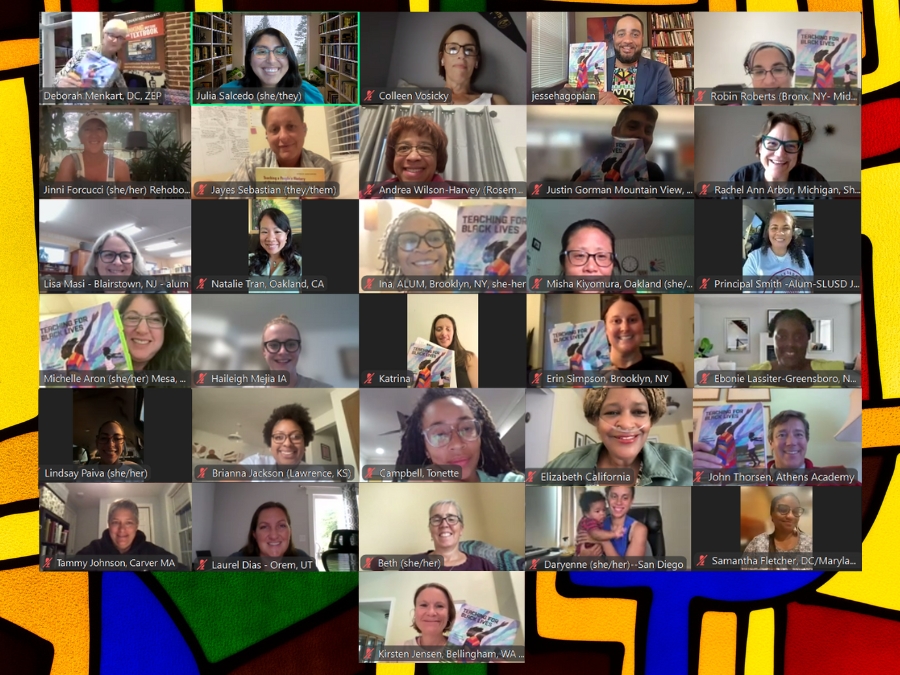In August, Teaching for Black Lives study group coordinators gathered for an orientation session to plan for the 2024–2025 school year and meet other educators organizing groups across the country. Jesse Hagopian, co-editor of Teaching for Black Lives and ZEP team member, opened the session affirming the study groups’ work as a continuation of the long tradition of “fugitive pedagogy.” Hagopian said,
The fight for Black education began on the inception of slavery. Racism in the colonies was highlighted by one struggle in particular. On a Sunday, September 9th, 1739, an enslaved African man from Angola, Jemmy, launched the Stono Rebellion in South Carolina. Jemmy and other Africans assembled and hoisted a banner with one word on it, it read Liberty! The response was not only murdering the rebels but attempting to kill the idea of liberty by murdering the ability of Black people to ever write, read, or think the word Liberty again. In 1740, they passed the first laws banning literacy for Black people.
But this didn’t stop Black people from organizing and rebelling. They taught each other how to read and write. When the Civil War was over, Black people knew there was no emancipation without education, and they built the public school system in the U.S. During the Freedom Summer campaign of 1964, that we’re celebrating the anniversary of, more than 3,000 Black students attended a freedom school.
This is the tradition that we stand in today’s struggle for police free schools, for restorative justice, for ethnic studies, for Black studies, and the Black Lives Matter at School movement. You are all part of this timeline. I see the Teaching for Black Lives study groups as a part of carrying this tradition forward.
Hagopian played a one-minute clip of Charles Cobb, a SNCC veteran who wrote the treatise for Freedom Schools, and referenced the following quote from him:
Freedom Schools in 1964 were not simply an effort at remedying the issues of reading, writing, arithmetic, and history. They were part of the structure aimed at resisting the enslavement of Black minds.
In breakout groups, participants reflected on two questions:
- What is your relationship to this tradition?
- How are your goals for the study group aligned with this tradition?
With over 17 study groups continuing for another school year, each breakout room included one or two returning coordinators. Coordinators shared something they heard, shared, or noticed in their conversation:
I was excited by some of the groups who have been meeting for several years and how connected their groups are to action in their local communities
In Breakout Room 5, we are all excited about doing this work to disrupt the racist narrative that has kept Black folx in a state of miseducation.
Our group expressed that some of us work in schools with staff that is primarily white and there is a desire to understand what is happening for ALL of our students.
For the remainder of the session, coordinators reviewed the facilitation guide, and gathered in breakout rooms to discuss plans and/or concerns for their study groups.
Read what coordinators said:
The energy and enthusiasm! I am even more ready to get started after feeling the positivity and intentionality of Jesse and the incredible coordinators devoted to resistance and action!
Interactive, engaging, great ideas from peers, a good balance of input and time to digest and engage.
I am excited to think about how to build connections between study groups to share best practices!
I thought that the format was well thought out! I appreciated the historical framing offered at the beginning particularly.
I’m excited to get a plan in place, start getting the word out about the group to get more participants and to meet new people and have discussions to learn together.
I am not always a fan of breakout sessions but these sessions were quick, had specific questions and we had time to think about the questions before moving into the room.


